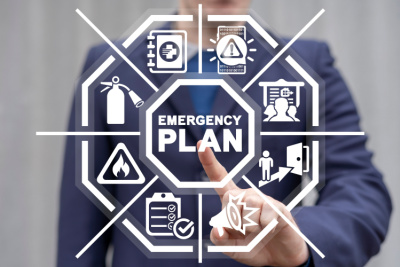Held on Sept. 26-27, our FM NOW: Emergency Preparedness virtual summit featured information about how crucial it is to plan for various types of hazards, including natural disasters, fires, power outages, and even active shooters. If you missed any of the webinars, here’s a rundown with key takeaways and links to FREE on-demand recordings.

Opening Keynote | Security Is a Constantly Evolving Responsibility
Speaker: Hector Alvarez, President, Alvarez Associates
Key Takeaways: Alvarez’s presentation centered on defining workplace violence and explaining ways that facilities professionals can work with building management to further protect their facilities.
“Workplace violence is any act or threat of physical violence, harassment, intimidation, or other threatening disruptive behavior that occurs in a work setting,” he explained.
Four types of workplace violence include:
- Criminal activity
- Customers/clients
- Coworkers
- Personal relationships
Additionally, Alvarez said that employees should best safeguard their facilities by taking action to protect themselves and listening to their intuition by reporting incidents involving threatening words and actions.
He said the “pathway” to violence includes:
- The grievance
- Violent ideation
- Research and planning the attack
- Pre-attack preparation
- Probing and breaches
- Attack
Lastly, Alvarez advocated using lights, landscaping, and locks to help reduce workplace violence.
Watch the full webinar on-demand here.
Educational Session | Facilities & Security Double Down on Emergency Responsiveness
Speaker: David Trask, National Director, ARC Facilities
Sponsor: ARC Facilities
Key Takeaways: Trask said that emergency management efforts should be coordinated among members of the facilities management and security departments.
Emergencies that they should be prepared to handle include:
- Workplace violence
- Active shooting incidents
- Natural disasters
- Burst water pipes
- Power outages
- Cyberattacks
Additionally, he explained that ensuring that facilities and security have access to up-to-date building documentation is key.
“The person who’s been there for 30 years or the person who started last week should be able to access information to do their job, and to react and respond quickly when something’s going sideways,” said Trask. “The more of this information that changes or more of the times that your building has changed, all those renovations mean more documentation.”
Such documentation includes emergency equipment locations and evacuation plans.
Lastly, he advocated that facilities and security departments collaborate through:
- Building layout familiarization
- Preventive maintenance awareness
- Emergency equipment maintenance
- Awareness of security concerns
- Collaborative meetings
Watch the full webinar on-demand here.
Educational Session | Understanding Water Quality Testing for Drinking Water & Stormwater
Speaker: Brian Davis, Director of Enterprise Accounts, Water Quality Testing, AQUALIS
Sponsor: AQUALIS
Key Takeaways: Maintaining water quality is essential to safeguarding public health. Davis explained drinking water parameters and contaminants are regulated by the U.S. Environmental Protection Agency (EPA) under the Safe Water Drinking Act (SDWA).
These include:
- Microbiological parameters
- Physical parameters
- Chemical parameters
- Radiological parameters
- Secondary contaminants
To meet those parameters, a drinking water testing program must be implemented.
Additionally, Davis called this program “a comprehensive initiative designed to assess and ensure the safety of the water supply provided to the public for consumption. The program involves regular testing and analysis of water samples from various sources, including municipal water systems, wells, springs, and other sources of drinking water.”
The program includes:
- Sample collection
- Testing and analysis
- Compliance assessment
- Public reporting
- Corrective actions
- Ongoing monitoring
Watch the full webinar on-demand here.
Panel Discussion | Protecting Your Facilities from Natural Disasters
Speakers: Dr. Jennifer Carlson, Ph.D., CEM, LCSW; and Tessa Baran, Prepare Program Associate, SBP
Moderator: Joe Bebon, Editor, Facilities Management Advisor
Key Takeaways: From hurricanes and tornadoes to wildfires and floods, there’s no denying that natural disasters are becoming more frequent and damaging. “The numbers don’t lie,” said Carlson. To protect property and life, it’s imperative that facilities managers be prepared before disaster strikes.
Carlson and Baran both agreed that communication is key, urging organizations to consult their local emergency management experts, establish a hazard analysis and business continuity plan, and provide clear messaging to all employees to ensure everyone’s on the same page.
To underscore the severity of the problem, Baran shared some startling statistics. For example, every inch of flood water can cause tens of thousands of dollars in facility damage, and up to 40% of businesses never reopen after a natural disaster.
In addition to creating emergency plans, the experts said facilities managers should take concrete steps, such as installing window shutters, laying sandbags, and ensuring proper back-up generator maintenance. They also noted that FEMA and other sites like Ready.gov offer valuable resources on emergency preparedness and disaster recovery.
Watch the full webinar on-demand here.
